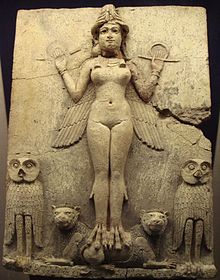Burney relief
The Burney relief , also known as the Queen of the Night relief , is a terracotta relief from the Isin Larsa period or from the ancient Babylonian period . It shows a winged, nude, female, anthropomorphic figure with bird's claws, flanked by owls and carried by lions - obviously a deity.
The relief comes from southern Iraq , but since it was purchased in the art trade, its exact origin is not clear. The relief came to England in 1924 and was first published in 1936. It is named "Burney Relief" after the owner at the time, Sir Sydney Bernard Burney. In 2003 the relief was acquired by the British Museum in London (Inv. ME 2003.07-18.1). After its authenticity was questioned several times, the British Museum performed thermoluminescent dating which confirmed its authenticity. Which deity is depicted on the relief is still discussed today. In addition to Ištar , her sister Ereškigal can also be considered ; Henri Frankfort interpreted the goddess as Lilith with a reference to the Gilgamesh epic .
literature
- Henri Frankfort : The Burney Relief , in Archive for Orient Research 12, 1937, pp. 128-135.
- Pauline Albenda: The "Queen of the Night" Plaque: A Revisit , in Journal of the American Oriental Society 125, 2005, pp. 171-190.
- Dominique Collon: The Queen of the Night. British Museum Objects in Focus. London 2005.
- Elisabeth Von der Osten-Sacken: To the goddess on the Burneyrelief , in S. Parpola, RM Whiting (ed.): Sex and Gender in the Ancient Near East. Proceedings of the XLVIIe Rencontre Assyriologique Internationale, Helsinki , Helsinki 2002, pp. 479-487.
